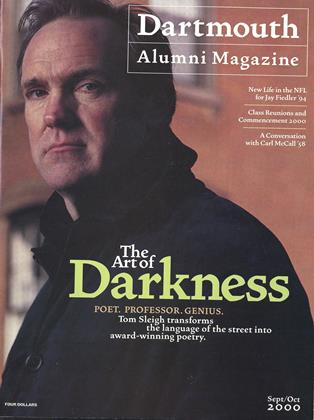IN THE ERA BEFORE COEDUCATION, SOCIAL LIFE AT DARTMOUTH centered around proms and the annual Winter Carnival ball. From the late 19th century through the first decades of the 20th, Dartmouth's fraternities and dance committees practiced the fine European and American etiquette of presenting dance cards to guests and hosts. Dance cards, in the form of small festive booklets, listed the order of dances—a dozen or two, from quadrilles to waltzes—and provided space to write in the name of a different partner for each dance. The most proper dance cards included slender pencils, attached by ribbons or tassled cords, to facilitate the pleasant task. And when the ball was over, dance cards preserved the afterglow. Tucked into scrapbooks beside programs of the athletic, musical and theatrical events that rounded out prom weeks and Winter Carnival, dance cards remain elegant mementos of times more formal than our own.
a) The Winter Carnival program from 1929 welcomed each "Queen of the Snow" with a key reminder: "You must have warm clothes!" b) The cover of the 1894 senior prom dance card featured John Milton's poetry: "Come, knit hands, and beat the ground in a light fantastic round." c) Dr. Seuss, a.k.a. Ted Geisel '25, drew cartoons for the 1932 Winter Carnival program booklet. d) The 1920 dance card of Ellis Briggs '21. e) Leather covers of dance cards doubled as wallets. f) The DOC carved its 1913 Winter Carnival dance cards out of wood. g) Dance cards for Kappa Kappa Kappa's 1907 annual promenade paired the fraternity's logo with an image of romance. h) Originating in 1899, the junior prom had become a major social event by 1901. i) Dance cards for the class of 1914's junior prom included space to record "Memories of this Dance."
 View Full Issue
View Full Issue
More From This Issue
-
 Feature
FeatureFox Trot
September | October 2000 By John Barton -
 Cover Story
Cover StoryThe Art of Darkness
September | October 2000 By KAREN ENDICOTT -
 Feature
FeatureTwo Years Before The Mast
September | October 2000 By Michel Marriott -
 Feature
FeatureCommencement and Reunions: A Sketchbook
September | October 2000 -
 PERSONAL HISTORY
PERSONAL HISTORYWhat is Perfect?
September | October 2000 By Mary Cleary Kiely ’79 -
 Sports
SportsMaking all the Right Moves
September | October 2000 By Brad Parks '96
Karen Endicott
-
 Article
ArticleDARTMOUTH AUTHORS
NOVEMBER 1988 By Karen Endicott -
 Article
ArticleThe Daughters of Eve
October 1993 By Karen Endicott -
 Article
ArticleWhy the Novel Matters
May 1994 By Karen Endicott -
 Article
ArticleDid Science Kill Mother Nature?
November 1994 By Karen Endicott -
 Article
ArticleHISTORY THAT WON'T FLY
May 1995 By Karen Endicott -
 CLASSROOM
CLASSROOMFrom the Page to the Stage
Mar/Apr 2002 By Karen Endicott
HISTORY
-
 HISTORY
HISTORYThe Life of Riley
July/August 2005 By Joe Bertagna -
 HISTORY
HISTORYA Matter of Degree
July/August 2001 By Karen Endicott -
 HISTORY
HISTORYNo Survivors
Mar/Apr 2009 By Karen Iorio ’10 -
 HISTORY
HISTORYRider on the Storm
Sept/Oct 2011 By Michael Gillis ’12 -
 HISTORY
HISTORYA House United
May/June 2011 By Michael Lasser ’57 -
 HISTORY
HISTORYOld Flames
NovembeR | decembeR By Sean Plottner


